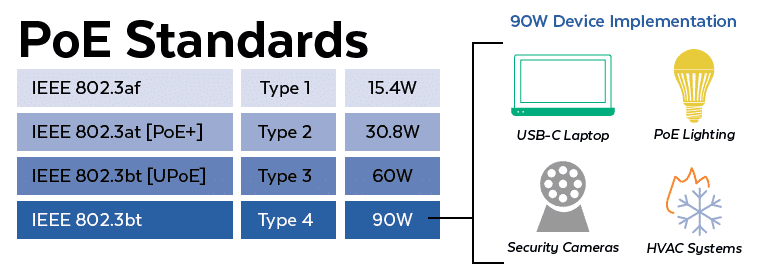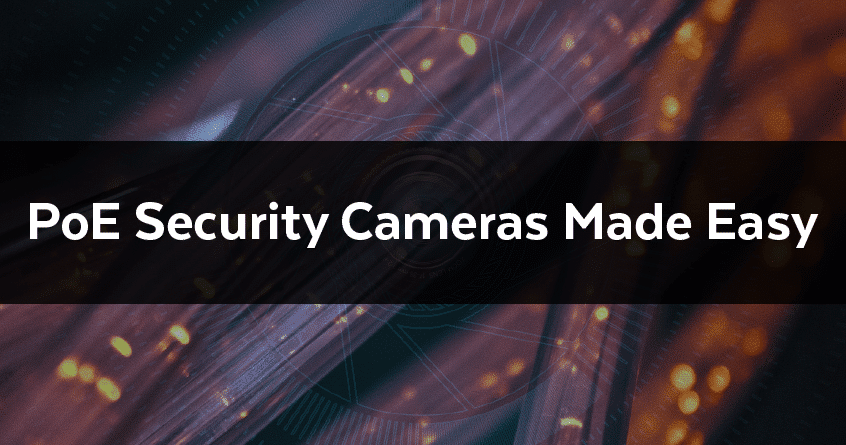Power over Ethernet (PoE) technology sends direct current (DC) to network devices over a single Cat5e or Cat 6 Ethernet cable. This highly-popular DC delivery solution is an economical way to power an ever-increasing range of enterprise network devices—LANs, LED lighting, display screens, monitoring systems, security cameras, biometric door locks, and more. It’s no secret that PoE is also very cost-effective. Consequently, businesses are doing their best to continue building out their IT infrastructure for PoE amidst several challenges:
- Skyrocketing inflation.
- Smaller talent pools.
- Limited budgets.
- The need for digital transformation to improve efficiency and increase visibility in the marketplace.
Decision-makers and IT professionals leverage tried and tested technologies like PoE to offset the challenges of extending the life of legacy equipment while supporting the more advanced technologies currently on the market. Not only does PoE support the expanding sophistication of the powered devices, but it is also easy to install.
What is PoE and How Does It Work?
Power over Ethernet (PoE) delivers DC power and data to low-powered devices (PDs) over a single Cat 5e, Cat 6, or Cat 6A Ethernet cable. PoE eliminates the need for having separate power supplies and outlets by delivering DC power over the same copper cable used for communication.

An Ethernet cable has eight wires, but only four are used for data transmission. The remaining four unused wires are used to transmit DC power in PoE. The IEEE standardizes PoE to promote interoperability across devices.
Why is this Technology So Valuable Right Now?
Initially, PoE emulated traditional PSTN (public switched telephone network) landlines by delivering DC power over the four unused pairs of twisted copper wires in a Cat 5 Ethernet cable. IEEE introduced the 802.3af standard to ensure PoE interoperability in a wider range of connected devices and power source equipment. To protect devices that do not support PoE, a 25-kW resistor was added. The value of PoE was realized by creating a cost-effective DC delivery solution. Transporting both power and data across a single cable:
- Reduced cabling needs.
- Improved equipment safety from overload, underpowering, and incorrect installation.
- Simplified installation, thus saving time and reducing costs.
PoE has proven so valuable, several improvements and additions had to be made to the IEEE 802.3af standard. There was a need for more power to support a broader range of devices. In 2018, the 802.3bt standard was adapted to increase power capability to 90W. Up to 90W devices can now be implemented, including security cameras, display screens, point of sale systems, LED lighting, kiosks, refrigerators, air conditioners, and even USB-C capable laptops!
Powering USB-C capable laptops will eliminate the traditional “power brick” and pave the way for a workspace (phone, monitor, lamp, laptop) that can be powered by a single cable. 90W PoE will also bring exciting changes for smart devices and assist with the transition to Ethernet-based industrial control systems. PoE can therefore make lighting an intelligent platform in connected buildings by integrating sensors, HVAC, security, and building management systems.
 How is PoE a Cost-Effective DC Delivery Solution?
How is PoE a Cost-Effective DC Delivery Solution?
PoE offers several benefits during and after installation. The most prominent benefit is its ability to reduce costs in the following ways:
- Eliminates the expense of having separate electrical wiring.
- Removes any need for hiring a professional electrician to install network cables. PoE is simply “plug and play”.
- Reduces the number of power outlets required per installed device.
- Saves energy costs by allowing centralized control over heating, cooling, lighting, and window shades.
Recently, businesses have transitioned from fluorescent and incandescent lighting to LED lighting, which requires less power and energy, has a longer lifespan, and is less expensive overall.
The Top 5 IT Infrastructure Management Challenges & Solutions
IT teams face challenges in ensuring that networks, data storage, backup systems, and servers are always properly maintained. The following are some of the dominant IT infrastructure management challenges facing businesses today:
- Increasing complexity: IT infrastructure has drastically changed over the years, with modern IT infrastructure diagrams being almost unrecognizable to the IT managers of yesteryear. PoE development fully supports the increasing complexity of the networks that are needed to support the PDs required in current networks.
- Demand for more availability and security: As networks grow, so too does the demand. With the rise of remote work, the need for SaaS programs delivered over the cloud or third-party vendors increases. Security solutions should not solve problems as they arise. Rather, such solutions should be scalable and accommodating of drastic changes to an organization’s size. The demand for more availability and security is supported by PoE switches that offer more layers of security.
- Lack of Integration & vendor freedom is making PoE more relevant: If IT managers do not integrate different vendor solutions based on the company’s needs, they cannot build a truly custom network and will have to compromise on features, security or redundancy. The IEEE standards, which are designed to improve interoperability, make PoE a flexible and dynamic solution.
- Multiple devices: IT managers have to keep track of a wide variety of devices in a network, which can be challenging in a large-sized network. Manufacturers often replace devices they deem no longer useful. These devices include servers, routers, switches, data backup devices, hardware for remote users, configuration devices, and cellular failover boxes. Solution: Multiple devices can share power budgets across all ports on a single PoE switch.
- Legacy Devices: As networks modernize, older devices become outdated and incapable of integrating with new technology by themselves. However, it is possible to use special equipment to bring them into the network. Legacy and new devices can be supported through a single managed switch using PoE extenders and injectors.
The Upshot
Power over Ethernet is a powerful and cost-effective DC delivery solution that is already widespread. As it grows to support more DC power, more devices will abandon the need for separate power cables and move towards a more straightforward network design with fewer cables. This will translate into lower costs and easier installations for businesses worldwide.
Find out more about the benefits of PoE technology. Visit Versa Technology for featured products, announcements, and video tutorials. Contact us if you need help with any PoE networking equipment for your network needs.

